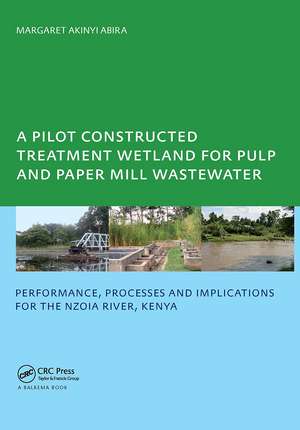A Pilot Constructed Treatment Wetland for Pulp and Paper Mill Wastewater: Performance, Processes and Implications for the Nzoia River, Kenya, UNESCO-IHE PhD
Autor Margaret Akinyi Abiraen Limba Engleză Paperback – dec 2008
The wetland effectively removed organic matter, suspended solids, phenols and nutrients. BOD and phenols reduction rates are reported for the first time. Design parameters and guidelines for the set-up and maintenance of a full-scale wetland are recommended. The study concludes that integrating a full-scale wetland, as a tertiary stage with the existing treatment ponds would significantly improve the quality of water in River Nzoia downstream of the effluent discharge.
This is a valuable resource book for scientists, managers and students in the field of wetland ecology, water and environmental management.
Preț: 385.02 lei
Preț vechi: 498.39 lei
-23% Nou
Puncte Express: 578
Preț estimativ în valută:
73.68€ • 76.83$ • 61.24£
73.68€ • 76.83$ • 61.24£
Carte tipărită la comandă
Livrare economică 21 martie-04 aprilie
Preluare comenzi: 021 569.72.76
Specificații
ISBN-13: 9780415467155
ISBN-10: 0415467152
Pagini: 160
Ilustrații: 32 b/w images, 30 tables and 7 color halftones
Dimensiuni: 178 x 254 x 10 mm
Greutate: 0.32 kg
Ediția:1
Editura: CRC Press
Colecția CRC Press
ISBN-10: 0415467152
Pagini: 160
Ilustrații: 32 b/w images, 30 tables and 7 color halftones
Dimensiuni: 178 x 254 x 10 mm
Greutate: 0.32 kg
Ediția:1
Editura: CRC Press
Colecția CRC Press
Cuprins
1. General Introduction; 2. Quality of treated wastewater of Pan African Paper Mills (E.A) Ltd; 3. The design, hydrology and flow characteristics of the pilot-scale constructed wetland; 4. Plant growth and nutrient removal efficacy; 5. The efficacy of the constructed wetland in removing organic matter and suspended solids; 6. Phenol removal: efficiency, processes and implications; 7. Discussion, conclusions and outlook
Descriere
This study provides insight into the performance of a constructed treatment wetland receiving pulp and paper mill wastewater in the tropics. It explores the efficacy of a pilot wetland in improving the quality of the final effluent. The wetland effectively removed organic matter, total suspended solids (TSS), phenols and nutrients. Plants played a significant role in the removal of phenols, nutrients, and TSS. The study reports time reduction rates for BOD and phenols in a constructed wetland for pulp and paper mill wastewater and gives recommendations for design, set-up, and maintenance of a full-scale facility.






